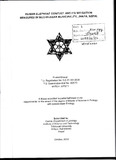Please use this identifier to cite or link to this item:
https://elibrary.tucl.edu.np/handle/123456789/1467| Title: | Human.Elephant Conflict Measures in Mechinagar Municipality, Jhapa' Nepal |
| Authors: | Khanal, Puskal |
| Keywords: | human-elephant |
| Issue Date: | 2020 |
| Publisher: | Central Department of Zoology |
| Abstract: | The eastern lowland of Jhapa district has higher number of incidents of HEC due to the seasonal migration of elephants from India and the presence of local solitary elephants. So, the research was conducted with the aim to explore the present status of elephanthuman conflict and its mitigation measures being applied recently in Mechinagar Municipality, Jhapa. Mechinagar Municipality ward number one and four were selected as the study area as they had frequent incidents of HEC. Questionnaire surveys, group discussions and interviews were conducted and data was collected during NovemberDecember 2018. Ten percent of households were selected from the research area by simple random technique for questionnaire survey. People who were residing in the research area since five to ten years were selected for the interview. Twelve villagers who were directly and indirectly involved in the management of HEC in research area were selected for focus group discussion. The areas susceptible to HEC were visited with the help of field guide. Data analysis and data representation was done by using appropriate statistical tools of Microsoft excel 2013. The areas near the bank of Mechi River ward number one and four located near the Mechi River had more impacts of HEC. Crop damage by elephant was higher in compared to physical damage, livestock damage and human casualties. Months of June, July, November and December had high intensity of crop damage and human casualties. Lack of habitat and corridor in the border area, lack of sufficient vegetation in forest and migratory behaviour of elephants were the major causes of HEC. The survey of 180 households showed that, there was a total economic loss of Rs. 3,526,525 annually due to HEC. In average, each household were bearing the annual loss of Rs. 23,592.29 due to crop damage by elephant. Maize damage accounted the highest among the crops. In spite of several mitigation measures being adopted, the incidents of HEC was still prevailing in the Mechinagar area. However, solar fencing along the bank of Mechi river was found to be the most effective measure to reduce the HEC in the research area. |
| URI: | http://elibrary.tucl.edu.np/handle/123456789/1467 |
| Appears in Collections: | Zoology |
Files in This Item:
| File | Description | Size | Format | |
|---|---|---|---|---|
| thesis.pdf | 4.43 MB | Adobe PDF |  View/Open |
Items in DSpace are protected by copyright, with all rights reserved, unless otherwise indicated.
